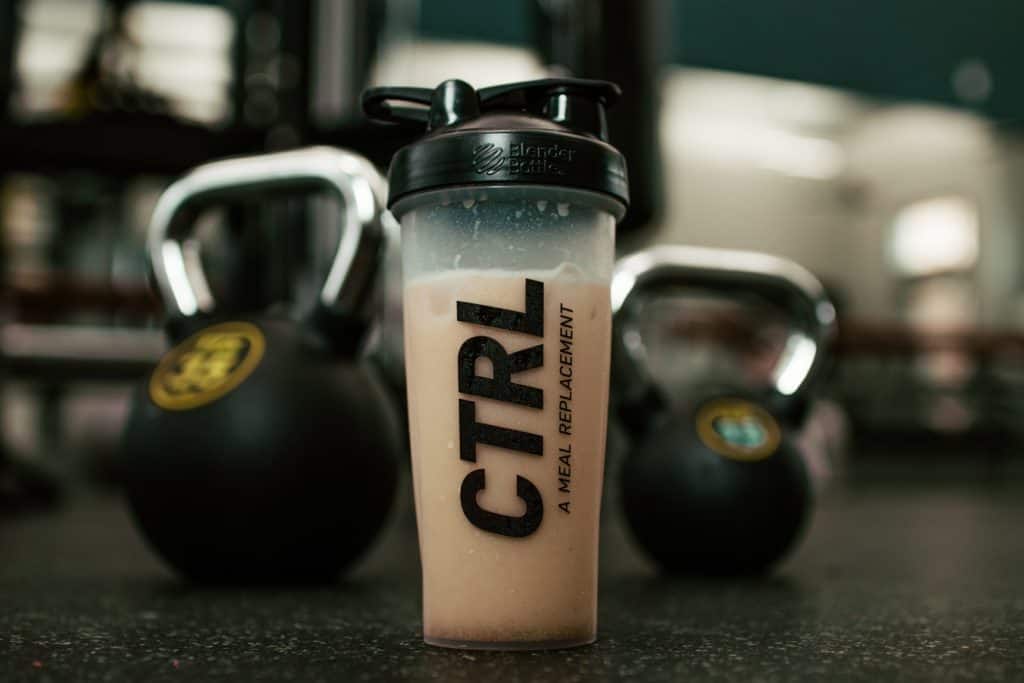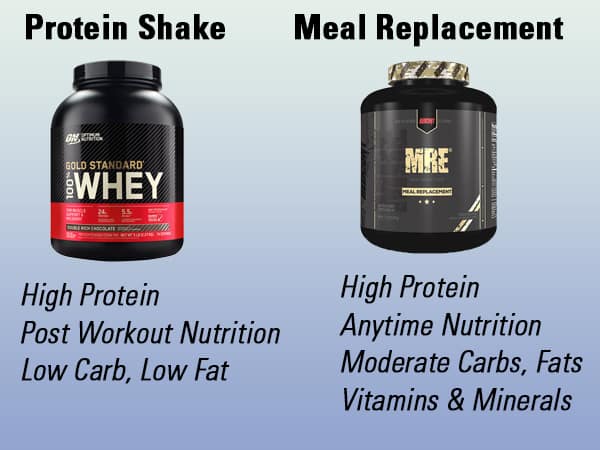
All protein shakes are not created equal. Different protein shakes are more optimal in different situations.
Your fitness goals are not the only thing that determines which protein powder to choose. Conceivably, a person cutting and a person bulking could choose the same product. The structure of a person’s diet as a whole determines whether they will gain or lose weight, not just the supplementation.
The question you need to ask yourself is what you want your shake to accomplish. Are you just looking for a lean source of protein, or something more comprehensive?
A regular whey protein shake is nearly 100% protein, with minimal fats and carbohydrates added. A meal replacement will have sufficient protein, carbohydrates, and fats, along with micronutrients.
A meal replacement shake contains more calories, greater diversity in macronutrients, and a more comprehensive vitamin and mineral profile. This is what it’s designed to do, replace a meal. A balanced meal will have different food sources, so a meal replacement shake will mimic that by containing more nutrients than a typical whey shake.
A good meal replacement should keep you more satiated than a regular protein shake, which will digest more rapidly.
A protein shake cannot replace a meal on its own. If you purchased whey protein powder thinking it was a meal replacement don’t worry, there are easy ways to make a protein shake into a meal replacement.
How to Turn a Protein Shake Into a Meal Replacement
Any protein shake can be turned into a meal replacement if you know what to add. A meal replacement should contain moderate carbohydrates and fats, along with fiber, vitamins and minerals. With the original protein powder, the protein needs are already covered.
There are numerous ways to add carbohydrates to a protein shake. Carbohydrates are the most variable part of the diet. Some people, like athletes or people looking to put on a lot of muscle, have high carbohydrate needs. People looking to maintain or lose weight will have lower needs.
It is rare that anyone should avoid carbs completely; even people who are dieting should consume some carbs to fuel their training and recovery.
Since we want to make a meal replacement shake as nutrient dense as possible, the best options for carb sources will be a fruit or oats.
Different fruits provide different vitamins and minerals. Some are more carbohydrate dense than others. For example, on a gram by gram basis, bananas will have more carbs than blackberries. Diversity is key to health, so don’t hesitate to switch fruit sources or choose multiple fruits.
If you’re looking for something filling, choose a fruit high in fiber. Strawberries, blackberries, and raspberries are excellent sources of fiber.
Oats provide both soluble and insoluble fiber. It’s important to have both in your diet. It’s not unusual for someone to have proportionally more of one type compared to the other.
Blending oats into a protein shake makes it filling due to the texture of the oats and the fiber content. They’re a good source of iron and other minerals as well. It may sound strange to blend raw, uncooked oats into a shake but it tastes quite good.
Fats are the slowest digesting macronutrient, and will also slow the digestion of other nutrients when eaten in conjunction with them. For example, if you spread peanut butter onto a banana, it would slow the digestive rate of the banana. This is why a good fat source is important to a quality meal replacement.
A meal replacement shake should sustain your appetite for a few hours. Fat sources like nut butters, avocado, fish oil, and coconut oil can all be blended into a meal replacement shake. Whole milk is also a good fat source so long as the person consuming it isn’t lactose intolerant.
Fats are the most calorically dense of all macronutrients; containing 9 calories per gram while protein and carbohydrates contain 4 calories per gram. Therefore, it’s important to measure fat sources carefully and not just chuck spoonfuls of peanut butter into a shake.
When turning a regular protein shake into a meal replacement, it’s best to choose vanilla flavored protein if possible. Vanilla goes with any fruit, oats, or fat source you choose. Choosing a flavor like cookie dough or cinnamon bun limits your options.

Benefits of Meal Replacement Shakes
The main appeal of a meal replacement supplement is convenience. Many people want to live a healthy lifestyle but don’t have the time or resources to consume 3-5 meals per day. A meal replacement can bridge the gap between regular, healthy meals.
Meal replacement shakes aren’t inherently special in any way. They don’t provide anything you can’t get from food, but again some people just can’t eat at certain times of day. Some meal replacements tout weight loss benefits, but the entire context of the diet will determine weight loss, not one meal.
With that said, using meal replacements can still help with weight loss from a compliance standpoint. Many times people stray from their diet when they are unprepared, which leads to consuming too many calories by eating out. Having a shake ready can thwart the impulse to cheat on the diet.
Meal replacement supplements come in powders and RTD (ready-to-drink) versions. The RTD supplements will be in a bottle, carton or can. While they taste better chilled, many of them don’t require refrigeration.
The RTDs that require refrigeration are ones that contain milk, like Shamrock Farms Rockin’ Protein. However most are derived from whey or casein, which do not require refrigeration.
How to Choose a Meal Replacement Supplement
Some supplements are marketed as meal replacements, but the nutrition profile doesn’t fit the criteria.
For example, this Garden of Life product is marketed as a meal replacement, but is only 130 calories with 2 grams of fat and 12 grams of carbs per serving. This isn’t to say it’s a bad product, it’s actually quite nutrient dense from a micronutrient (vitamins, minerals, antioxidants) perspective. However it lacks the macronutrients (protein, carbohydrates, fats) to be considered a true meal replacement.
There are numerous brands that offer different nutritional profiles. You should be able to find something to fit your needs. To do this, first you need to determine what the protein source will be.
Meal replacements come in whey, vegan, and other varieties. A good meal replacement with whey protein as the base is Labrada. It contains 7 grams of fat, 21 grams of carbs, 7 grams of fiber, and 35 grams of protein per serving. It also has a full vitamin and mineral profile.
For something more carbohydrate dense you can look at Redcon1’s meal replacement. It comes in a variety of flavors, all of which have similar profiles (4g fat, 75g carbs, 8g fiber, 47g protein). Redcon1 has a blend of whole food based proteins like beef, pea, and chicken. This is beneficial for people who do not tolerate whey protein well but still want a quality source.
What is the Best Meal to Replace with a Shake?
There is no limitation as to which meal a meal replacement should be used for. However, I’ve found that most people don’t wake up with much of an appetite. At the same time, you probably want to eat something before work that will sustain you until lunch.
Choosing a meal replacement will satisfy early morning nutrition needs, while also not sitting heavy in the stomach. No one wants to go to work or the gym feeling stuffed and bloated.
The only meal that you probably shouldn’t replace is dinner. Even though it’s called a meal replacement shake, an actual meal will always leave you more satisfied. It can be hard to sleep when you’re hungry, so having an actual meal for dinner may be a better choice than opting for a shake. You don’t want to go to bed hungry knowing you’ve already allotted your calories for the day.
Recent Posts
Stretching Before Workouts: Essential Warmup or Performance Killer
“Don’t stretch before workouts, your muscles become too supple” “Stretch before your workouts, warming up is important” It's conflicting advice like this that drives people crazy,...
Best Protein Bar For the Money | Cost Effective, High Quality
Protein bars are no longer a supplement dedicated to diehard gym rats, with awful taste and the consistency of a brick. Men, women, and even teenagers can commonly be seen eating protein bars. The...
